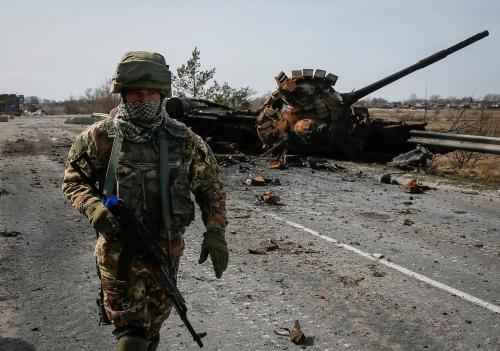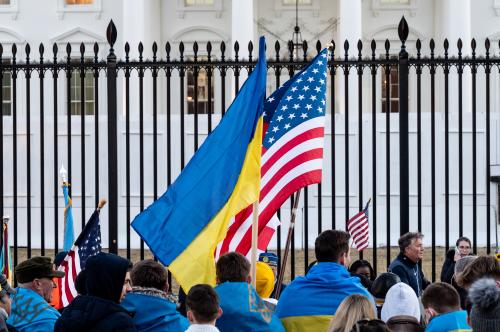Previous versions of this article incorrectly referred to Nielsen by the previous name of the entity, “Nielsen Scarborough.”
The Russian invasion of Ukraine has generated much debate in America, not only about what how the U.S. should respond, but also about the extent to which the invasion represents a threat to democracy. There have been questions about the extent to which Russia’s assault has galvanized public support behind NATO, whether the war has ended the post-Cold War era as we have known it, and about the nature of the Biden administration’s response. It has also generated discussion about the degree to which the Russia-Ukraine war has eroded the deep American partisan divide in recent years. I set out to probe public perceptions of these issues in a new poll.
It turns out that large majorities of Americans are indeed following the Russian invasion closely, according to our University of Maryland Critical Issues Poll. The poll was carried out online between March 16 to 28, 2022 by Nielsen, who used a nationally representative sample of 1,320 adults with a margin of error of +/- 2.7%. It found that 40% of respondents say they are following the crisis “very closely,” and another 45% say they are following somewhat closely. Here are twelve takeaways:
1
Americans clearly view Ukraine as being far more friendly than Russia, even if most Americans don’t simply consider Russia to be an enemy or Ukraine to be a full ally. Thirty-four percent of respondents say Russia is an enemy, including 30% of Republicans and 40% of Democrats, while 38% say Russia is an “unfriendly country,” and 24% say it is neither friendly nor unfriendly. Nineteen percent consider Ukraine an ally, while a slight majority of 54% consider Ukraine a “friendly country,” and 25% consider it neither friendly nor unfriendly.
2
Large bipartisan majorities remain opposed to sending U.S. troops to Ukraine, even if the conflict persists. Sixty-five percent oppose sending troops, including 68% of Republicans and 62% of Democrats. At the same time, a large majority, 83%, supports supplying the Ukrainian army with military equipment, including 82% of Republicans and 86% of Democrats. Similarly, 89% of those polled support continuing to impose tough sanctions on Russia, including 85% of Republicans and 95% of Democrats.
3
If the Russian invasion persists, small bipartisan majorities will support a no-fly zone over Ukraine, even as large majorities of Americans express concern about the possibility of fighting Russians and of nuclear conflict. Fifty-six percent of respondents say they support enforcing a no-fly zone over Ukraine, including 52% of Republicans and 61% of Democrats. Despite this view, most respondents also expressed overwhelming concern about potential U.S. military confrontation with Russia (61% were “very” concerned and another 28% were “somewhat concerned”). Nuclear fears also weighed heavily: 58% were also “very concerned” and another 24% “somewhat concerned” about potential nuclear confrontation with Russia.
4
Americans view the U.S. response to the Ukraine crisis more favorably than unfavorably but are divided in their attitude along party lines. Forty-nine percent say their opinion of the U.S. reaction has been favorable, including 31% of Republicans and 69% of Democrats, compared to 31% who express unfavorable opinions, including 49% of Republicans and 13% of Democrats. A further 20% express neither favorable nor unfavorable opinions. Most Americans, 51%, say the U.S. reacted at the “appropriate level,” but a majority of Republicans, 56%, say the U.S. has “underreacted.” Two-thirds of Americans support U.S. President Joe Biden’s decision to end importing Russian energy, including 56% of Republicans and 80% of Democrats.
5
Most Americans, including majorities of Democrats and Republicans, say they are prepared to pay some price in energy costs and inflation for supporting Ukraine, but not in American lives. Seventy-three percent say they are at least somewhat prepared to pay higher energy costs, including 88% of Democrats and 58% of Republicans, while 65% are at least somewhat prepared to see increased inflation, including 78% of Democrats and 51% of Republicans. At the same time, 68% of Americans are “not at all” (41%) or “not much” (27%) prepared to accept loss of lives of U.S. troops. This holds across the partisan American divide, but Republicans are much more likely to “not at all” accept casualties (47%), compared to Democrats (33%).
6
U.S. policy toward Ukraine has impacted the public perceptions of Biden and former President Donald Trump more negatively than positively, driven by highly partisan attitudes. Thirty-six percent say they now have more favorable views of Biden, 23% say their views are unaffected, while 41% say they have more negative views, including 80% of Republicans. Thirty-four percent say they now have more positive views of Trump, 26% say their views were unaffected, while 40%, including 72% of Democrats, say they have more negative views of Trump.
7
Although U.S. government messaging on Ukraine has been partly focused on defending democracy around the world, most Americans across the partisan divide don’t believe the U.S. is now a good model for democracy. Only 27% say that democracy in the U.S. is a good example for other countries to follow, including 28% of Democrats and 29% of Republicans. A large majority, 61%, say the U.S. “used to be a good example but has not been in recent years”, including 64% of Republicans and 58% of Democrats.
8
Americans are divided on whether their country should be leading the international opposition to the Russian invasion, with 47% saying the U.S. should be the one to lead (42% of Republicans and 55% of Democrats), while 53% say it should not (58% of Republicans and 45% of Democrats).
9
Overwhelmingly, Americans across the partisan divide blame Russia for the crisis and few blame Ukraine. At the same time, a significant percentage also blame the U.S. Ninety-eight percent say Russia is to blame, 29% say Ukraine bears at least some of the blame, and 36% say the U.S. bears at least some of the blame, including half of Republicans.
10
While Americans say NATO’s expansion played a role in Russian behavior, most don’t think this was the key to Russia’s invasion of Ukraine. Thirty-eight percent say the expansion of NATO played a key role in the Russian invasion of Ukraine, 41% say NATO expansion played “a small but not a key role,” while 21% say it played no role.
11
Most Americans (57%) say the post-Cold War era has ended. Among those who hold that view, most blame Russian behavior, but a smaller majority also blame American behavior. Ninety-two percent say Russian behavior contributed to the demise of the post-Cold War era (64% say “a lot” and 28% say “somewhat”), while 73% say American behavior contributed (30% say “a lot” while 43% say “somewhat”).
12
Americans support receiving Ukrainian refugees in small or moderate numbers but oppose unlimited numbers. Twenty percent say the U.S. should accept “small” numbers, 36% would accept “moderate” numbers, and 30% would accept refugees without a limit, including 45% of Democrats and 16% of Republicans. Fourteen percent would not accept any refugees, including 20% of Republicans and 7% of Democrats.
The Ukraine crisis has managed to eliminate or narrow the deep American partisan divide on several issues, including what steps the U.S. should take, and how much the public is prepared to pay for confronting the Russian invasion of Ukraine. But on issues that bear directly on electoral politics, such as evaluating the Biden administration’s response, and attitudes toward Biden and Trump, the deep American partisan divide appears to be less affected by the war.
It is striking that, unlike their leaders, large majorities of Americans across the partisan divide no longer view American democracy as providing a good example for the world. It is also notable that a slight majority of Americans does not want to see the U.S. take the lead in confronting the crisis; and that, one month into Russia’s war in Ukraine, most Americans are still reluctant to call Russia an “enemy” and Ukraine an “ally.”
The Brookings Institution is committed to quality, independence, and impact.
We are supported by a diverse array of funders. In line with our values and policies, each Brookings publication represents the sole views of its author(s).






Commentary
What do Americans think of the Russia-Ukraine war and of the US response?
March 31, 2022